A Smart Autonomous Time- and Frequency-Domain Analysis Current Sensor-Based Power Meter Prototype Developed over Fog-Cloud Analytics for Demand-Side Management
Abstract
:1. Introduction
- A smart autonomous time- and frequency-domain analysis current sensor-based power meter prototype, which co-operates with cloud analytics (AI trained offline in cloud analytics) for collaborative learning and serves as edge analytics to identify electrical appliances onsite and online over fog-cloud analytics for DSM in a smart grid (well-trained AI autonomously and automatically deployed onsite on the prototype via the Internet (representational state transfer (REST) application programming interface (API))), is presented in this study. The prototype presented in our previous work [23] is upgraded in this study, which was based on time-domain feature extraction and was not autonomously and automatically collaborated with cloud analytics. The upgraded prototype in this study is a novel IoT end (edge) device, as compared with the work done in [20,21,22,23]. The prototype developed over fog-cloud analytics and presented in this study is experimentally examined. The prototype has assembled hardware and software to be developed.
- An open and powerful cloud analytics platform is configured and used as a data science analytics engine without developing custom web software for DSM to implement lightweight AI trained offline in cloud analytics and deployed, via the Internet (REST API), onsite on the prototype as edge analytics for online load identification in the presented fog-cloud analytics-based AIoT architecture.
- In AI, a model such as an artificial neural network (ANN) trying too hard to respond to noisy data in a training dataset should avoid overfitting. Regularization is one of the most important techniques used in AI to overcome overfitting. A radial basis function ANN (RBF-ANN) that takes a regularization risk function into account is employed in this study as lightweight AI. It has the low computational complexity of AI (lightweight AI) implemented in cloud analytics and deployed via the Internet (REST API) onsite on the presented prototype as edge analytics autonomously and automatically for online load identification in DSM. The RBF-ANN is a typical feed-forward ANN, which has the merits of (1) a simple network structure and (2) conspicuous fast and high learning and generalization performance.
2. Methodology: Smart Autonomous Time and Frequency Analysis Current Sensor-Based Power Meter Prototype in an Edge Analytics-Based AIoT Architecture Launched with an Open Cloud Analytics Platform
2.1. Architectural Design of an Edge Analytics-Based AIoT Considering the Developed Smart Autonomous Time and Frequency Analysis Current Sensor-Based Power Meter Prototype with Open Cloud Analytics for DSM in a Smart Grid
2.1.1. Hardware: Smart Autonomous Time and Frequency Analysis Current Sensor-Based Power Meter Prototype as Edge Analytics
- (1)
- A current transducer (CT) coil, which is clipped on a live electrical wire and used to acquire current signals. Acquired current signals reflect electrical appliances monitored by the prototype, analyzed through time- and frequency-domain analysis, and identified by advanced AI. For a CT connected to an Arduino® MCU, the output signal from the CT needs to be conditioned so it meets the input requirements, positive voltage between 0 V and the ADC reference voltage (AREF; 5 V on 5 V MCU boards or 3.3 V on 3.3 V boards), of the Arduino® MCU’s analog inputs.
- (2)
- A WIZNet W5100 hardwired TCP/IP embedded Ethernet shield, which is used to support Internet connectivity where data processed through time and frequency analysis are transmitted to the open and powerful cloud analytics platform in Figure 2 and Figure 3 for advanced AI, and where advanced AI well trained offline in cloud analytics is retrieved from the cloud analytics platform and autonomously and automatically deployed as edge analytics on the Arduino MEGA 2560 MCU in a regular periodic manner.
- (3)
- A real-time clock (RTC) chip, which is used to keep track of current time, timestamps, via network time protocol (NTP; the developed prototype designed and implemented to interact with the cloud analytics platform in Figure 2 and Figure 3 for advanced AI trained offline in cloud analytics and ported as edge analytics on the prototype via the Internet is time-synchronized).
- (4)
- A micro SD card, which is used to store data (the SD library built on ‘sdfatlib’ by Greiman allows for reading data from and writing data to the SD card, and data gathered are reliably replicated on the cloud analytics platform).
- (5)
- Advanced AI, which is ported from the cloud analytics platform to the developed prototype via the Internet and used as edge analytics to identify electrical home appliances (represented as electrical features) based on time- and frequency-domain analysis onsite and online.
2.1.2. Software: Open and Powerful Cloud Analytics Platform Based on ThingSpeak™ with MATLAB® Analytics
- (1)
- Collect (historical) IoT data (electrical feature data). Electrical features are extracted from appliances and learned by advanced AI in cloud analytics for DSM, such as load identification, fault detection and classification, and prognostics and health management. Advanced AI well trained in cloud analytics will be autonomously and automatically deployed on, or ported on, onsite the developed smart autonomous power meter prototype via the Internet for on-demand data science analytics and data visualization.
- (2)
- Perform data science analytics in the ThingSpeak™ cloud.
- (2.1)
- Analyze collected IoT data (electrical feature data), which are statistically inspected and cleaned to remove noise, outliers, missing or erroneous values, and anomalies.
- (2.2)
- Implement advanced AI applied on analyzed data for interpretable and actionable insights (code advanced AI in a MATLAB® script), publish the coded script in the ThingSpeak™ cloud, and then schedule the published script to regularly/periodically execute the implemented advanced AI for DSM such as load identification, fault detection and classification, and prognostics and health management.
- (3)
- Deploy on-demand data science analytics over fog-cloud analytics for the implemented advanced AI onsite on the developed prototype at the edge of the Internet. Over fog-cloud analytics, the prototype communicates with the ThingSpeak™ cloud for model updates and transmits analyzed and classified data to the ThingSpeak™ cloud for model scheduling and updating.
2.2. Advanced AI: K-Means Clustering Combined with RBF-ANN Trained Offline in Cloud Analytics and Autonomously and Automatically Deployed Onsite on the Developed Smart Autonomous Power Meter Prototype as Edge Analytics via the Internet
- (1)
- Stage 1. Apply k-means clustering to the onsite collected training data points, to heuristically determine the center and spread parameters of each Gaussian basis function of Equation (1). The Gaussian-type basis function’s centers are spanned, as computed by Equation (7). K-means clustering, which is used in this stage to characterize the RBF-ANN of Equation (1) trained in the following stage, is summarized below:
- Step 1. Suppose an onsite collected training dataset with is given. Fix c (k-means or hard c-means clustering), where 2 ≤ c < Q. Initialize U(0) ∈ Mc, where Mc = {U ∈ Vcn | uik ∈ {0, 1}, 1 ≤ i ≤ c, 1 ≤ k ≤ Q; ; are true}; Vcn is the set of real c × Q matrices U = [uik] (hard c-partition space for ).
- Step 2. At iteration l, where l = 0, 1, 2, …, compute the c-mean centers using Equation (8). In Equation (8), [uik(l)] = U(l) and i = 1, 2, … c:
- Step 3. Update U(l) to U(l+1) = [uik(l+1)] using Equation (9), where data points with short distances among them should be grouped together:
- Step 4. Compare U(l) with U(l+1): if ||U(l+1) − U(l)|| < ε for a prespecified small tolerance, stop; otherwise, set l = l + 1 and go to Step 2. The cluster centers found by Equation (8) through k-means clustering are used to heuristically determine the center and spread parameters of each Gaussian basis functions of Equation. (1). Data points with short distances among them are clustered together by k-means clustering and learned by an exponential of a distance measure between the data points and their cluster center that characterizes the Gaussian basis function at a hidden neuron in the hidden layer of the RBF-ANN in Figure 6.
- (2)
- Stage 2. Use the SVD technique applied to Equation (6) with the training data points collected onsite to train the standard RBF-ANN of Equation (1) characterized in Stage 1. Once the k-means clustering combined with RBF-ANN has been well trained in the ThingSpeakTM cloud, it is autonomously and automatically deployed onsite on (ported on) the developed smart autonomous power meter prototype as edge analytics via the Internet. Then, the developed prototype is used to perform online load identification for DSM.
3. Experiments
3.1. Demo Prototype and Evaluation
| Algorithm 1. The two-stage method developed for the advanced AI k-means clustering-integrated RBF-ANN over fog-cloud analytics in this study. |
| • Use k-means clustering on a training dataset collected onsite, , to heuristically determine the center and spread parameters of each Gaussian basis function of the RBF-ANN of Equation (1). ↬ Require the values of the number of cluster centers c and a small constant of the tolerance ε to be specified. ↬ Randomly initialize the c cluster centers, where c has been specified. l ← 0 ↬ Repeat Compute the c cluster centers using Equation (8). Update the hard c-partition space U using Equation (9). l ← l + 1 Until ||U(l+1) − U(l)|| is less than the specified small tolerance ε. ↬ Return the resulting c cluster centers with the hard c-partition space for . ↬ Center the Gaussian basis functions of Equation (1) at the returned c cluster centers. ↬ Compute the spread parameters of the centered Gaussian basis functions of Equation (1) using Equation (7). |
| • Use Equation (6) involving the SVD technique applied to the training dataset collected onsite, , to train the RBF-ANN of Equation (1) characterized by k-means clustering. ↬ Train Equation (1), whose Gaussian basis functions were heuristically determined by k-means clustering applied to the training data points collected onsite using Equation (6) in the ThingSpeakTM cloud to get W. The well-trained RBF-ANN is then autonomously and automatically deployed onsite on the developed smart autonomous power meter prototype as edge analytics via the Internet for online load identification in DSM. In this study, the RBF-ANN facilitated with k-means clustering is developed over fog-cloud analytics. |
- (1)
- Use the MATLAB® Analysis app [66,67] to read, analyze, and write data for advanced AI (data science analytics) implemented in MATLAB® programming language and trained offline in the ThingSpeak™ cloud.
- (1.1)
- Read collected electrical feature data.
- (1.2)
- Analyze collected electrical feature data accessed from the fields of the ThingSpeak™ channel, electrical energy management, where advanced AI, the RBF-ANN facilitated with k-means clustering, is investigated, implemented, and trained on the processed electrical feature data in the ThingSpeak™ cloud.
- (1.3)
- Write the trained RBF-ANN facilitated with k-means clustering to the fields of the ThingSpeak™ channel, where advanced AI, the trained k-means clustering-combined RBF-ANN, is retrieved by the developed prototype via the Internet (refer to Figure 7c) and autonomously and automatically deployed onsite as edge analytics for on-demand data science analytics for DSM.
- (2)
- Use the TimeControl app [66,67] to schedule the coded MATLAB® script to regularly train advanced AI, the RBF-ANN facilitated with k-means clustering, for model updates. The advanced AI trained and scheduled in the ThingSpeak™ cloud is remodeled under a specific date range of collected (historical) electrical feature data learned with timestamps in a regular periodic manner for model updates (historical electrical feature data can be weighed in chronological order for user-centric IoT-oriented applications in DSM [8] because there are more non-working than working hours in a week, activities of daily living by occupants related to electricity can lead to more electrical energy wasted during non-working hours than consumed during working hours [68,69,70]).
- (3)
3.2. Discussion
4. Conclusions and Future Work
Author Contributions
Funding
Acknowledgments
Conflicts of Interest
References
- Esther, B.P.; Kumar, K.S. A survey on residential Demand Side Management architecture, approaches, optimization models and methods. Renew. Sustain. Energy Rev. 2016, 59, 342–351. [Google Scholar] [CrossRef]
- Javaid, N.; Ahmed, F.; Ullah, I.; Abid, S.; Abdul, W.; Alamri, A.; Almogren, A.S. Towards cost and comfort based hybrid optimization for residential load scheduling in a smart grid. Energies 2017, 10, 1546. [Google Scholar] [CrossRef]
- Arun, S.L.; Selvan, M.P. Intelligent residential energy management system for dynamic demand response in smart buildings. IEEE Syst. J. 2018, 12, 1329–1340. [Google Scholar] [CrossRef]
- Hussain, H.M.; Javaid, N.; Iqbal, S.; Hasan, Q.U.; Aurangzeb, K.; Alhussein, M. An efficient demand side management system with a new optimized home energy management controller in smart grid. Energies 2018, 11, 190. [Google Scholar] [CrossRef]
- Gellings, C.W. The concept of demand-side management for electric utilities. Proc. IEEE 1985, 73, 1468–1470. [Google Scholar] [CrossRef]
- Bozchalui, M.C.; Hashmi, S.A.; Hassen, H.; Cañizares, C.A.; Bhattacharya, K. Optimal operation of residential energy hubs in smart grids. IEEE Trans. Smart Grid 2012, 3, 1755–1766. [Google Scholar] [CrossRef]
- Rosselló-Busquet, A.; Soler, J. Towards efficient energy management: Defining HEMS and smart grid objectives. Int. J. Adv. Telecommun. 2011, 4, 249–263. [Google Scholar]
- Lin, Y.H.; Tsai, M.S. An advanced home energy management system facilitated by nonintrusive load monitoring with automated multiobjective power scheduling. IEEE Trans. Smart Grid 2015, 6, 1839–1851. [Google Scholar] [CrossRef]
- Lin, Y.H.; Hu, Y.C. Residential consumer-centric demand-side management based on energy disaggregation-piloting constrained swarm intelligence: Towards edge computing. Sensors 2018, 18, 1365. [Google Scholar] [CrossRef]
- Lin, Y.H. Design and implementation of an IoT-oriented energy management system based on non-intrusive and self-organizing neuro-fuzzy classification as an electrical energy audit in smart homes. Appl. Sci. 2018, 8, 2337. [Google Scholar] [CrossRef]
- Taoa, M.; Zuo, J.; Liu, Z.; Castiglione, A.; Palmieri, F. Multi-layer cloud architectural model and ontology-based security service frame-work for IoT-based smart homes. Future Generat. Comput. Syst. 2018, 78, 1040–1051. [Google Scholar] [CrossRef]
- Mengistu, M.A.; Girmay, A.A.; Camarda, C.; Acquaviva, A.; Patti, E. A cloud-based on-line disaggregation algorithm for home appliance loads. IEEE Trans. Smart Grid 2019, 10, 3430–3439. [Google Scholar] [CrossRef]
- Tsai, P.H.; Hong, H.J.; Cheng, A.C.; Hsu, C.H. Distributed analytics in fog computing platforms using tensorflow and kubernetes. In Proceedings of the 2017 19th Asia-Pacific Network Operations and Management Symposium (APNOMS), Seoul, Korea, 27–29 September 2017; pp. 145–150. [Google Scholar]
- Markakis, E.K.; Karras, K.; Zotos, N.; Sideris, A.; Moysiadis, T.; Corsaro, A.; Alexiou, G.; Skianis, C.; Mastorakis, G.; Mavromoustakis, C.X.; et al. EXEGESIS: Extreme edge resource harvesting for a virtualized fog environment. IEEE Commun. Mag. 2017, 55, 173–179. [Google Scholar] [CrossRef]
- Froiz-Míguez, I.; Fernández-Caramés, T.M.; Fraga-Lamas, P.; Castedo, L. Design, implementation and practical evaluation of an IoT home automation system for fog computing applications based on MQTT and ZigBee-WiFi sensor nodes. Sensors 2018, 18, 2660. [Google Scholar] [CrossRef] [PubMed]
- Jang, I.; Lee, D.; Choi, J.; Son, Y. An approach to share self-taught knowledge between home IoT devices at the edge. Sensors 2019, 19, 833. [Google Scholar] [CrossRef] [PubMed]
- Yazici, M.T.; Basurra, S.; Gaber, M.M. Edge machine learning: Enabling smart Internet of Things applications. Big Data Cogn. Comput. 2018, 2, 26. [Google Scholar] [CrossRef]
- Bonomi, F.; Milito, R.; Zhu, J.; Addepalli, S. Fog computing and its role in the Internet of Things. In Proceedings of the First Edition of the MCC Workshop on Mobile Cloud Computing, Helsinki, Finland, 17 August 2012; pp. 13–16. [Google Scholar]
- Fernández-Caramés, T.M.; Fraga-Lamas, P.; Suárez-Albela, M.; Díaz-Bouza, M.A. A fog computing based cyber-physical system for the automation of pipe-related tasks in the Industry 4.0 shipyard. Sensors 2018, 18, 1961. [Google Scholar] [CrossRef]
- Idrees, Z.; Zou, Z.; Zheng, L. Edge computing based IoT architecture for low cost air pollution monitoring systems: A comprehensive system analysis, design considerations & development. Sensors 2018, 18, 3021. [Google Scholar] [CrossRef]
- Vidal-Pardo, A.; Pindado, S. Design and development of a 5-Channel Arduino-based data acquisition system (ABDAS) for experimental aerodynamics research. Sensors 2018, 18, 2382. [Google Scholar] [CrossRef]
- Mnati, M.J.; Van den Bossche, A.; Chisab, R.F. A smart voltage and current monitoring system for three phase inverters using an Android smartphone application. Sensors 2017, 17, 872. [Google Scholar] [CrossRef]
- Chen, Y.Y.; Lin, Y.H.; Kung, C.C.; Chung, M.H.; Yen, I.H. Design and implementation of cloud analytics-assisted smart power meters considering advanced artificial intelligence as edge analytics in demand-side management for smart homes. Sensors 2019, 19, 2047. [Google Scholar] [CrossRef] [PubMed]
- Ruano, A.; Hernandez, A.; Ureña, J.; Ruano, M.; Garcia, J. NILM techniques for intelligent home energy management and ambient assisted living: A review. Energies 2019, 12, 2203. [Google Scholar] [CrossRef]
- Hart, G.W. Non-intrusive appliance load monitoring. IEEE Proc. 1992, 80, 1870–1891. [Google Scholar] [CrossRef]
- Zeifman, M.; Roth, K. Non-intrusive appliance load monitoring: Review and outlook. IEEE Trans. Consum. Electron. 2011, 57, 76–84. [Google Scholar] [CrossRef]
- Zoha, A.; Gluhak, A.; Imran, M.A.; Rajasegarar, S. Non-intrusive load monitoring approaches for disaggregated energy sensing: A survey. Sensors 2012, 12, 16838–16866. [Google Scholar] [CrossRef] [PubMed]
- Agyeman, K.A.; Han, S.; Han, S. Real-time recognition non-intrusive electrical appliance monitoring algorithm for a residential building energy management system. Energies 2015, 8, 9029–9048. [Google Scholar] [CrossRef]
- Sarkar, S.; Chatterjee, S.; Misra, S. Assessment of the suitability of fog computing in the context of Internet of things. IEEE Trans. Cloud Comput. 2015, 6, 46–59. [Google Scholar] [CrossRef]
- Tomovic, S.; Yoshigoe, K.; Maljevic, I.; Radusinovic, I. Software-defined fog network architecture for IoT. Wirel. Pers. Commun. 2017, 92, 181–196. [Google Scholar] [CrossRef]
- Ain, Q.-U.; Iqbal, S.; Khan, S.A.; Malik, A.W.; Ahmad, I.; Javaid, N. IoT operating system based fuzzy inference system for home energy management system in smart buildings. Sensors 2018, 18, 2802. [Google Scholar] [CrossRef]
- Jo, B.; Khan, R.M.A. An Internet of Things system for underground mine air quality pollutant prediction based on Azure machine learning. Sensors 2018, 18, 930. [Google Scholar] [CrossRef]
- Mukherjee, M.; Shu, L.; Wang, D. Survey of fog computing: Fundamental, network applications, and research challenges. IEEE Commun. Surv. Tutor. 2018, 20, 1826–1857. [Google Scholar] [CrossRef]
- Amini, M.H.; Nabi, B.; Haghifam, M.R. Load management using multi-agent systems in smart distribution network. In Proceedings of the 2013 IEEE Power & Energy Society General Meeting, Vancouver, BC, Canada, 21–25 July 2013; pp. 1–5. [Google Scholar]
- Bahrami, S.; Wong, V.W.S. An autonomous demand response program in smart grid with foresighted users. In Proceedings of the 2015 IEEE International Conference on Smart Grid Communications (SmartGridComm), Miami, FL, USA, 2–5 November 2015; pp. 205–210. [Google Scholar]
- IoT Analytics—ThingSpeak Internet of Things. Available online: https://thingspeak.com/ (accessed on 12 December 2018).
- Discover IFTTT and Applets—IFTTT (IFTTT). Available online: https://ifttt.com/discover (accessed on 6 January 2019).
- Do More with Webhooks—IFTTT (Webhooks). Available online: https://ifttt.com/maker_webhooks (accessed on 6 January 2019).
- Arduino. Arduino Mega 2560. 2014. Available online: https://www.arduino.cc/en/Guide/ArduinoMega2560 (accessed on 12 December 2018).
- Arduino LLC. Language Reference. Available online: http://www.arduino.cc/en/Reference/HomePage (accessed on 2 October 2018).
- ArduinoEthernetShieldV1—Arduino. Available online: https://www.arduino.cc/en/Main/ArduinoEthernetShieldV1 (accessed on 12 December 2018).
- Gao, L.; Wang, Z.X.; Zhou, J.L.; Zhang, C. Design of smart home system based on ZigBee technology and R&D for application. Energy Power Eng. 2016, 8, 13–22. [Google Scholar]
- Ding, F.; Chen, X.; He, S.; Shou, G.; Zhang, Z.; Zhou, Y. Evaluation of a Wi-Fi signal based system for freeway traffic states monitoring: An exploratory field test. Sensors 2019, 19, 409. [Google Scholar] [CrossRef] [PubMed]
- Kim, K.; Myung, H. Sensor node for remote monitoring of waterborne disease-causing bacteria. Sensors 2015, 15, 10569–10579. [Google Scholar] [CrossRef] [PubMed]
- Strigaro, D.; Cannata, M.; Antonovic, M. Boosting a weather monitoring system in low income economies using open and non-conventional systems: Data quality analysis. Sensors 2019, 19, 1185. [Google Scholar] [CrossRef] [PubMed]
- Lin, Y.H. Novel smart home system architecture facilitated with distributed and embedded flexible edge analytics in demand-side management. Int. Trans. Electr. Energy Syst. 2019, 29, e12014. [Google Scholar] [CrossRef]
- Dinesh, C.; Nettasinghe, B.W.; Godaliyadda, R.I.; Ekanayake, M.P.B.; Ekanayake, J.; Wijayakulasooriya, J.V. Residential appliance identification based on spectral information of low frequency smart meter measurements. IEEE Trans. Smart Grid 2016, 7, 2781–2792. [Google Scholar] [CrossRef]
- Cooley, J.W.; Tukey, J.W. An algorithm for the machine calculation of complex Fourier series. Math. Comput. 1965, 19, 297–301. [Google Scholar] [CrossRef]
- Heideman, M.; Johnson, D.; Burrus, C. Gauss and the history of the fast Fourier transform. IEEE ASSP Mag. 1984, 1, 14–21. [Google Scholar] [CrossRef]
- Viciana, E.; Alcayde, A.; Montoya, F.G.; Baños, R.; Arrabal-Campos, F.M.; Zapata-Sierra, A.; Manzano-Agugliaro, F. OpenZmeter: An efficient low-cost energy smart meter and power quality analyzer. Sustainability 2018, 10, 4038. [Google Scholar] [CrossRef]
- MathWorks. Fast Fourier Transform (FFT). Available online: http://se.mathworks.com/help/matlab/math/fast-fourier-transform-fft.html (accessed on 2 June 2019).
- kosme/arduinoFFT: Fast Fourier Transform for Arduino—GitHub. Available online: https://github.com/kosme/arduinoFFT (accessed on 7 June 2019).
- Hann (Hanning) Window—MATLAB Hann—MathWorks. Available online: https://www.mathworks.com/help/signal/ref/hann.html (accessed on 7 June 2019).
- Hjort, A.; Holmberg, M. Measuring Mechanical Vibrations Using an Arduino as a slave I/O to an EPICS Control System; The FREIA Report Series (Physics Project with a Research Connection 5 hp, 1FA605); Uppsala University: Uppsala, Sweden, 2015. [Google Scholar]
- Arduino Playground—FlexiTimer2. Available online: https://playground.arduino.cc/Main/FlexiTimer2 (accessed on 20 April 2019).
- Arduino Playground—MsTimer2. Available online: https://playground.arduino.cc/Main/MsTimer2 (accessed on 20 April 2019).
- Kumar, S. Neural Networks: A Classroom Approach, International ed.; McGraw-Hill Education (Asis)/Tata McGraw-Hill Publishing Company Limited: New Delhi, India, 2005; pp. 304–329. [Google Scholar]
- Lloyd, S.P. Least squares quantization in PCM. IEEE Trans. Inf. Theory 1982, 28, 129–137. [Google Scholar] [CrossRef]
- Wang, L.X. A Course in Fuzzy Systems and Control; IE-Paperback; Pearson Education Taiwan Ltd.: Taipei, Taiwan, 2005; pp. 342–347. [Google Scholar]
- K-Means Clustering—MATLAB K-Means—MathWorks. Available online: https://www.mathworks.com/help/stats/kmeans.html (accessed on 27 June 2019).
- Matrix Inverse—MATLAB Inv—MathWorks. Available online: https://www.mathworks.com/help/matlab/ref/inv.html (accessed on 27 June 2019).
- Rumelhart, D.E.; Hinton, G.E.; Williams, R.J. Learning representations by back-propagating errors. Nature 1986, 323, 533–536. [Google Scholar] [CrossRef]
- Sudqi Khater, B.; Abdul Wahab, A.W.B.; Idris, M.Y.I.B.; Abdulla Hussain, M.; Ahmed Ibrahim, A. A lightweight perceptron-based intrusion detection system for fog computing. Appl. Sci. 2019, 9, 178. [Google Scholar] [CrossRef]
- Moody, J.; Darken, C.J. Fast learning in network of locally-tuned processing units. Neural Comput. 1989, 1, 281–294. [Google Scholar] [CrossRef]
- Wei, Y.; Wang, H.; Tsang, K.F.; Liu, Y.; Wu, C.K.; Zhu, H.; Chow, Y.-T.; Hung, F.H. Proximity environmental feature based tree health assessment scheme using Internet of Things and Machine Learning algorithm. Sensors 2019, 19, 3115. [Google Scholar] [CrossRef] [PubMed]
- ThingSpeak (ThingSpeak Documentation—MathWorks). Available online: https://www.mathworks.com/help/thingspeak/ (accessed on 14 June 2019).
- Get Started with ThingSpeak—MathWorks. Available online: https://www.mathworks.com/help/thingspeak/getting-started-with-thingspeak.html (accessed on 14 June 2019).
- Masoso, O.T.; Grobler, L.J. The dark side of occupants’ behaviour on building energy use. Energy Build. 2010, 42, 173–177. [Google Scholar] [CrossRef]
- Rafsanjani, H.N.; Ahn, C.R.; Alahmad, M. A Review of approaches for sensing, understanding, and improving occupancy-related energy-use behaviors in commercial buildings. Energies 2015, 8, 10996–11029. [Google Scholar] [CrossRef]
- Ahmed, N.; Levorato, M.; Li, G.P. Residential consumer-centric demand side management. IEEE Trans. Smart Grid 2017, 9, 4513–4524. [Google Scholar] [CrossRef]
- REST API—MATLAB & Simulink—MathWorks. Available online: https://www.mathworks.com/help/thingspeak/rest-api.html (accessed on 15 June 2019).
- Mathworks/Thingspeak-Arduino: ThingSpeak Communication Library for Arduino, ESP8266 and EPS32—GitHub. Available online: https://github.com/mathworks/thingspeak-arduino (accessed on 15 June 2019).
- ArduinoJson: Efficient JSON Serialization for Embedded C++. Available online: https://arduinojson.org/ (accessed on 11 July 2019).
- JSON Format—MATLAB & Simulink—MathWorks. Available online: https://www.mathworks.com/help/matlab/json-format.html (accessed on 5 July 2019).
- Postman | API Development Environment. Available online: https://www.getpostman.com/ (accessed on 5 July 2019).
- Wu, X.; Gao, Y.; Jiao, D. Multi-label classification based on random forest algorithm for non-intrusive load monitoring system. Processes 2019, 7, 337. [Google Scholar] [CrossRef]
- Chakraborty, D.; Elzarka, H. Advanced machine learning techniques for building performance simulation: A comparative analysis. J. Build. Perf. Simul. 2019, 12, 193–207. [Google Scholar] [CrossRef]
- Welikala, S.; Dinesh, C.; Ekanayake, M.P.B.; Godaliyadda, R.I.; Ekanayake, J. Incorporating appliance usage patterns for non-intrusive load monitoring and load forecasting. IEEE Trans. Smart Grid 2019, 10, 448–461. [Google Scholar] [CrossRef]

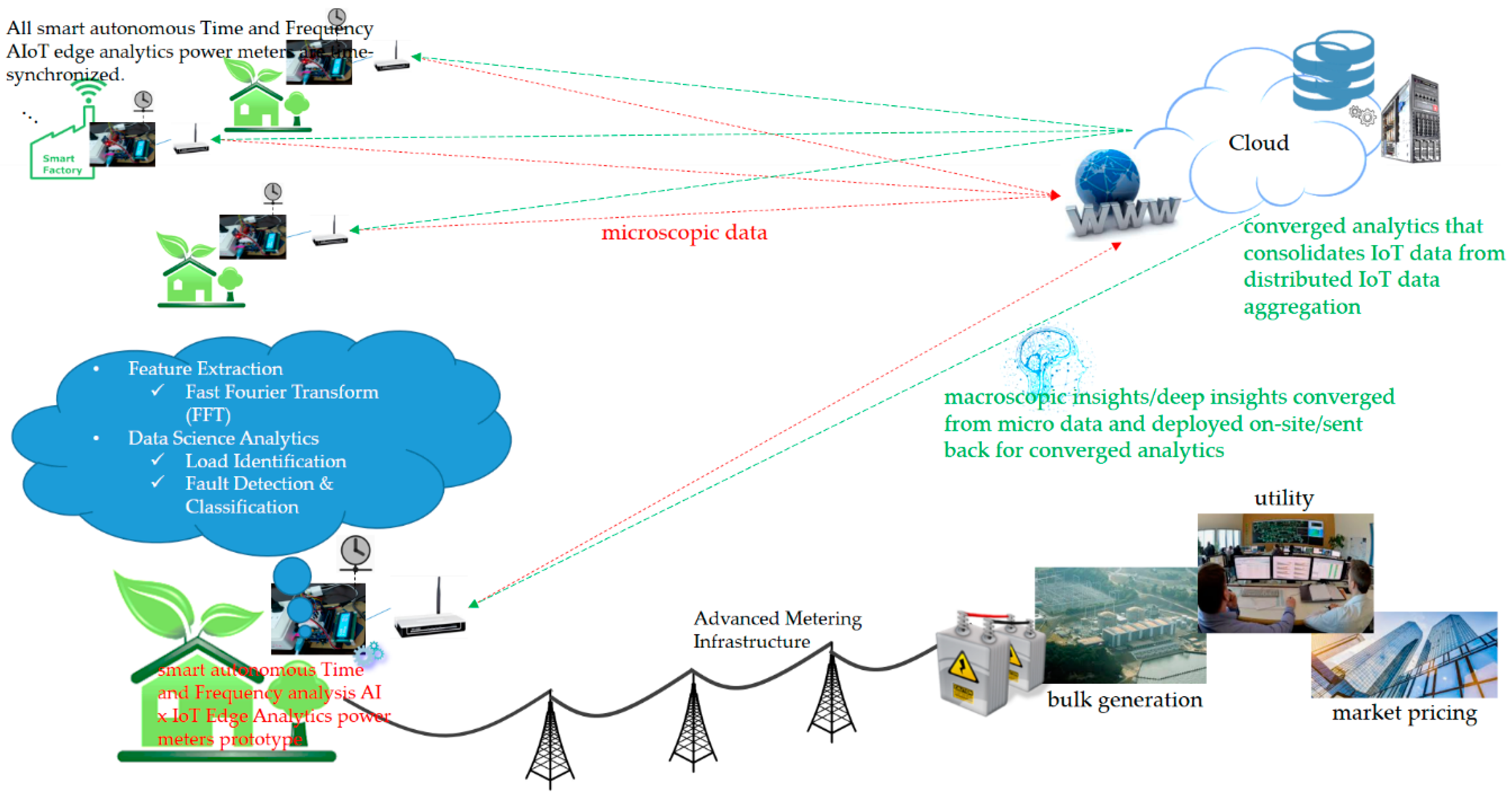
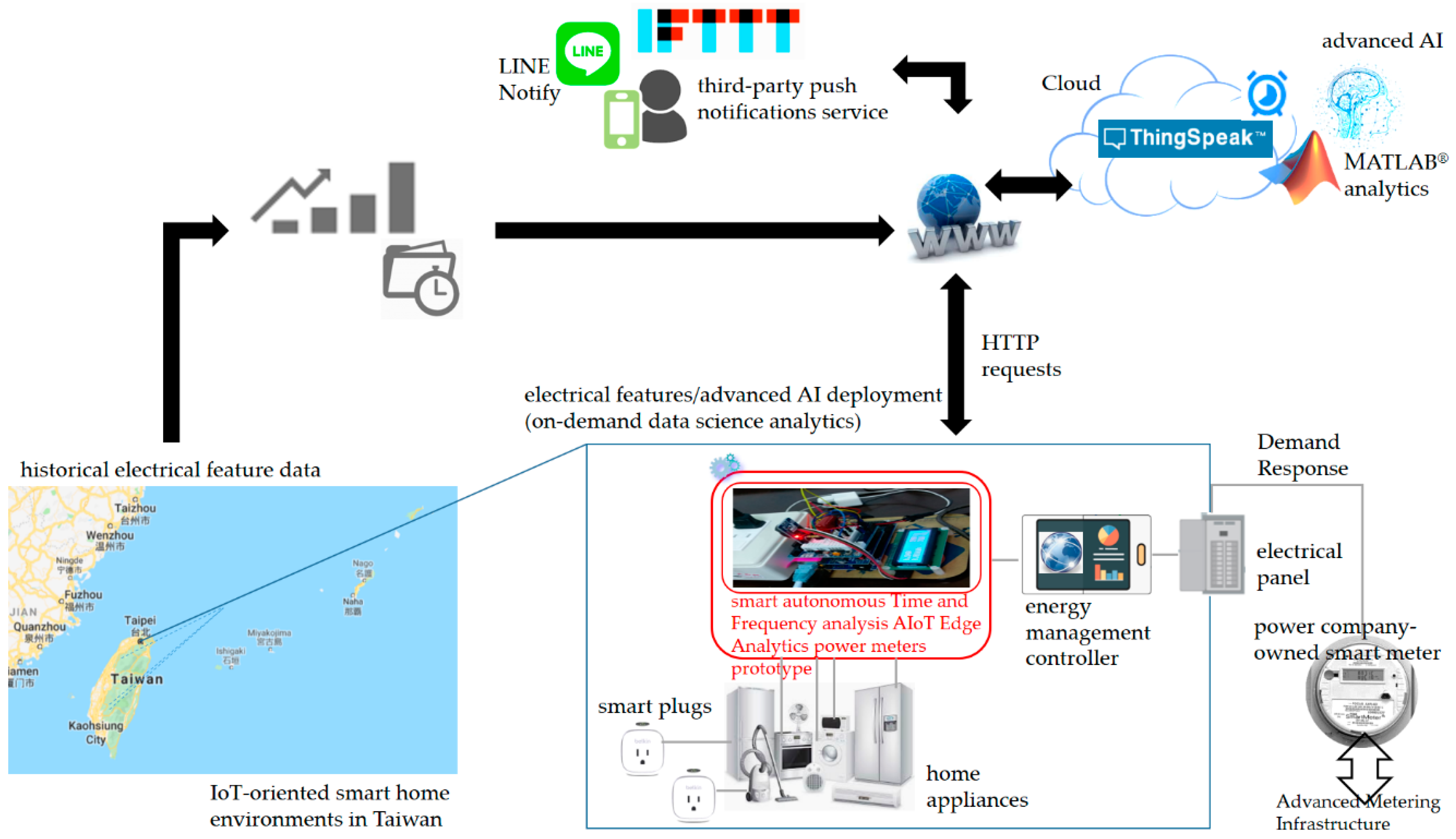
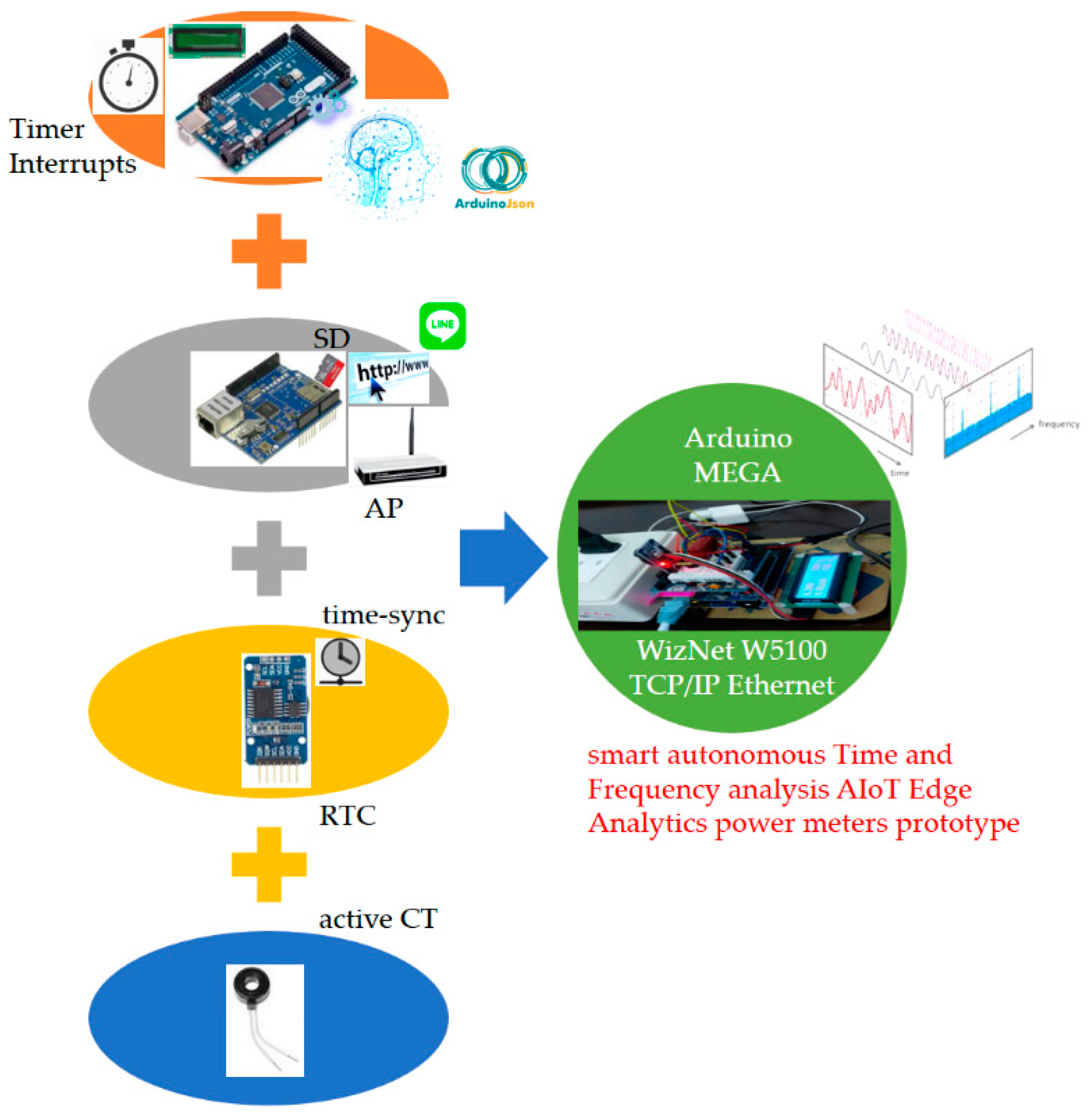
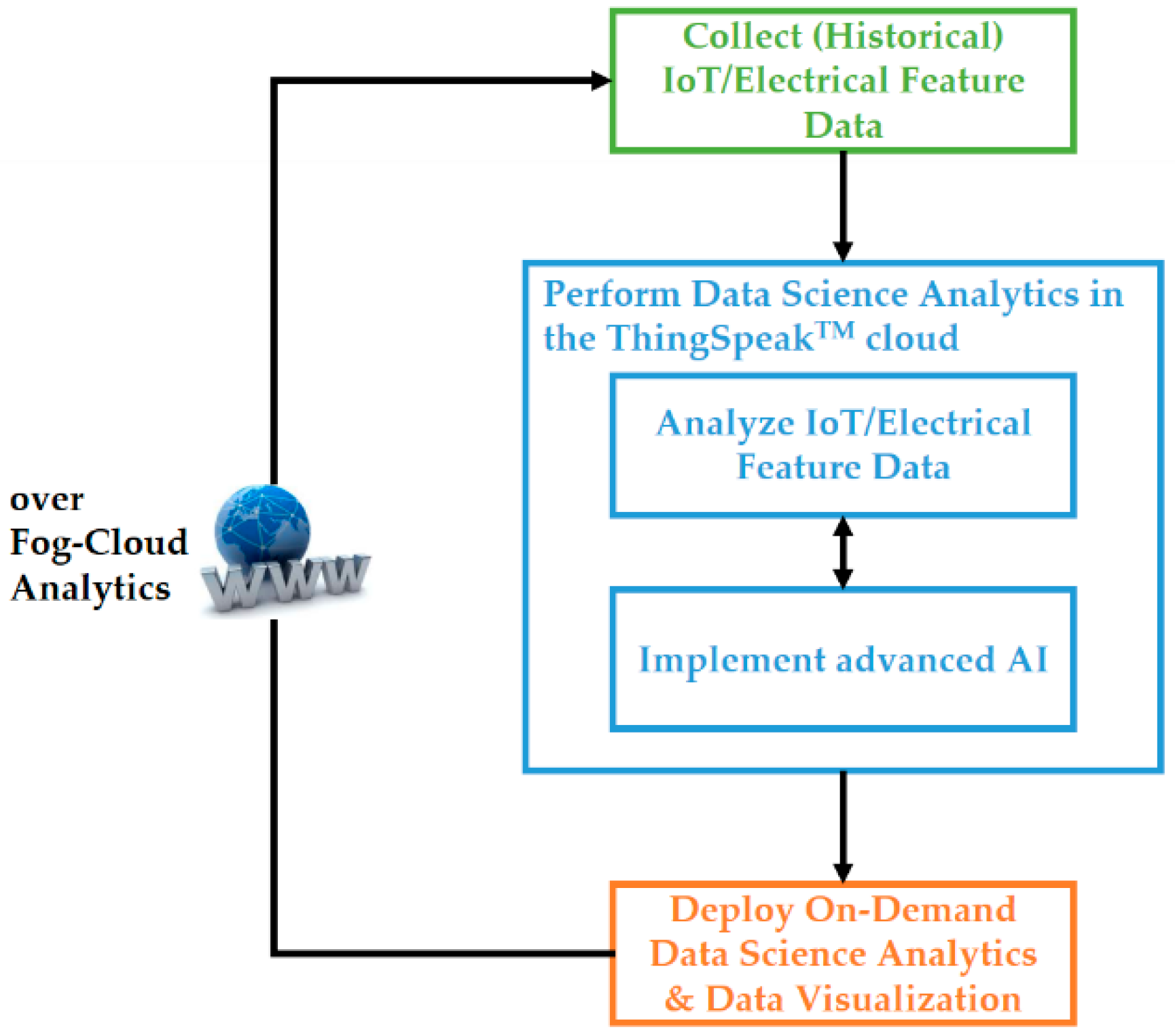
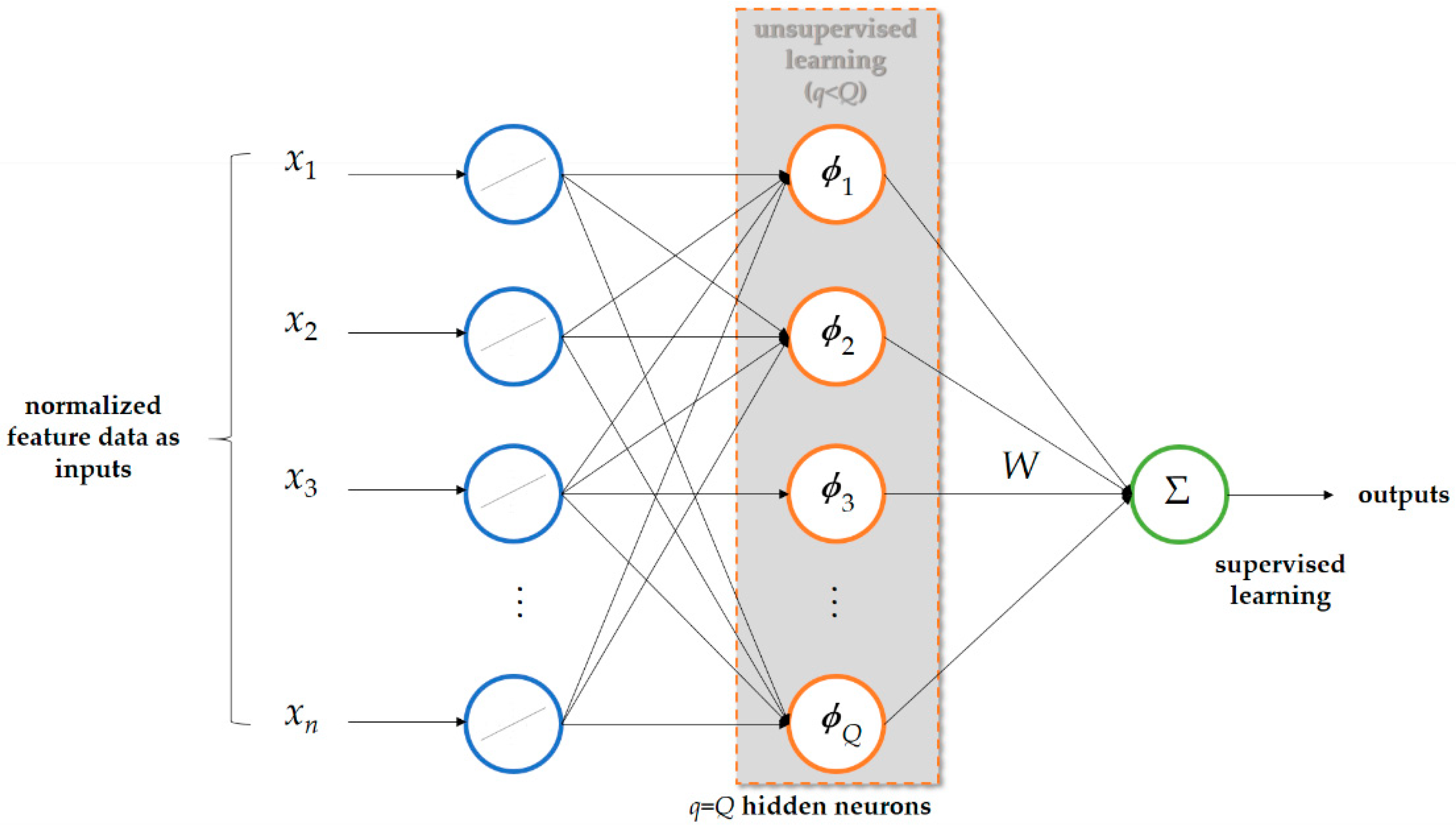
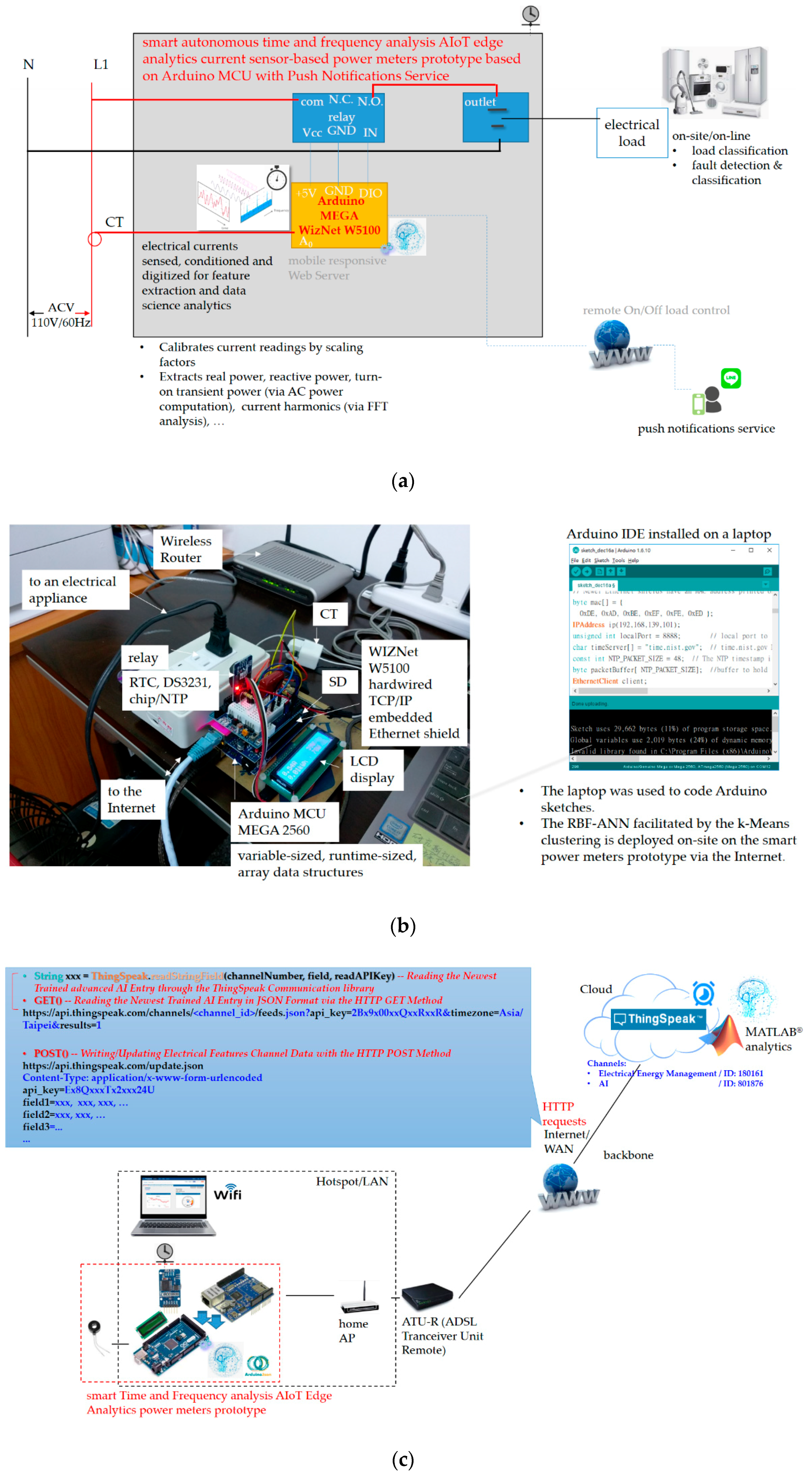
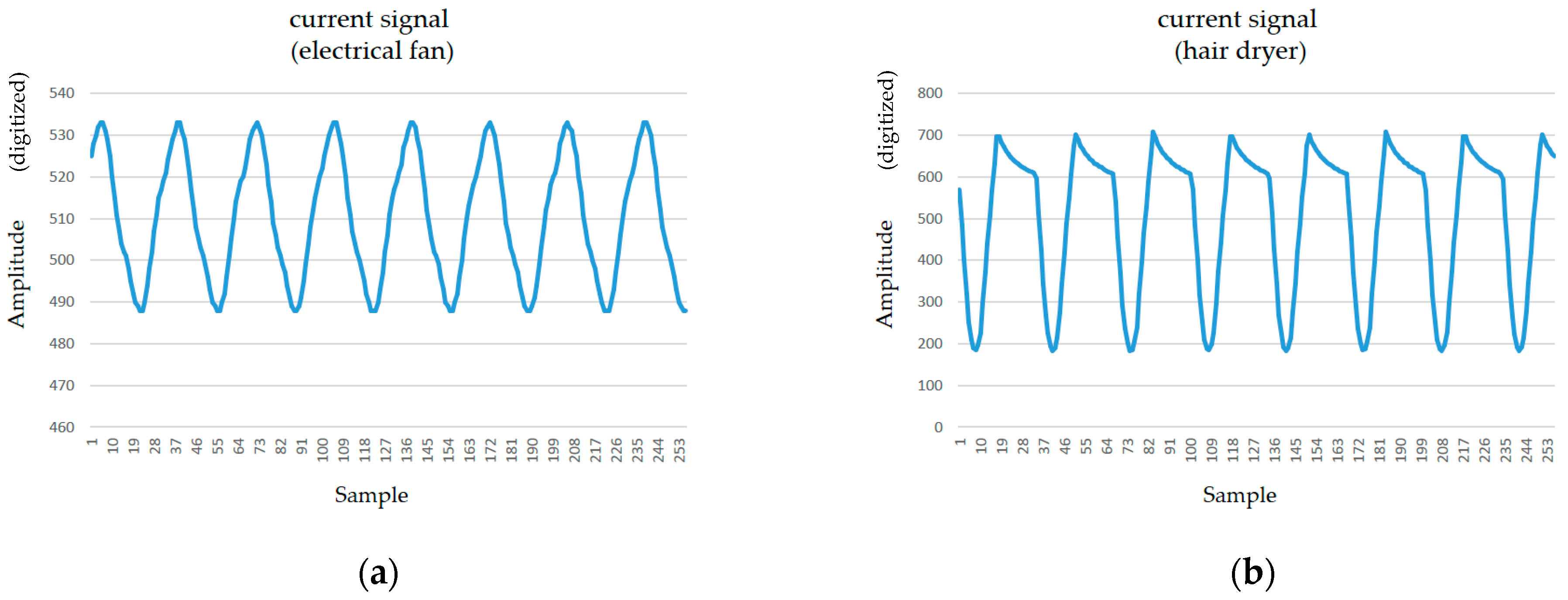
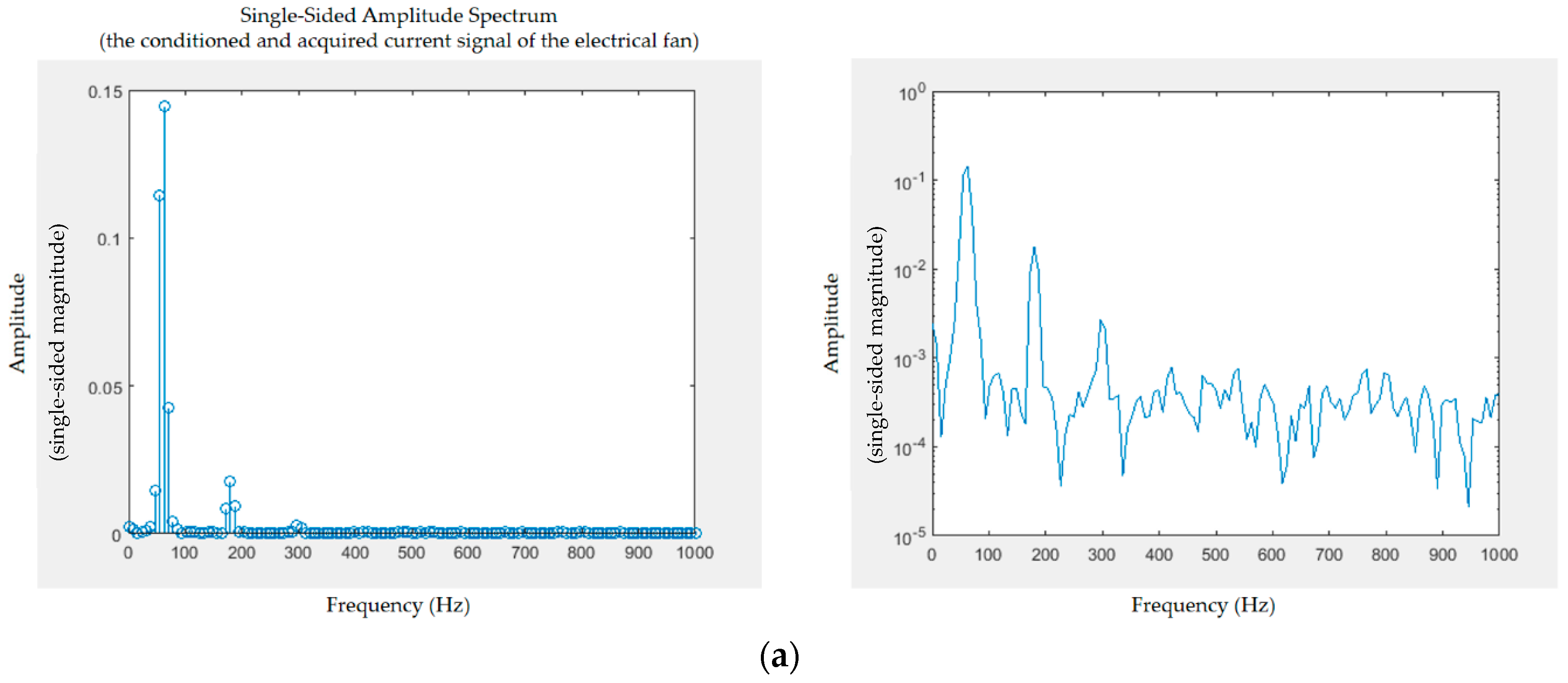
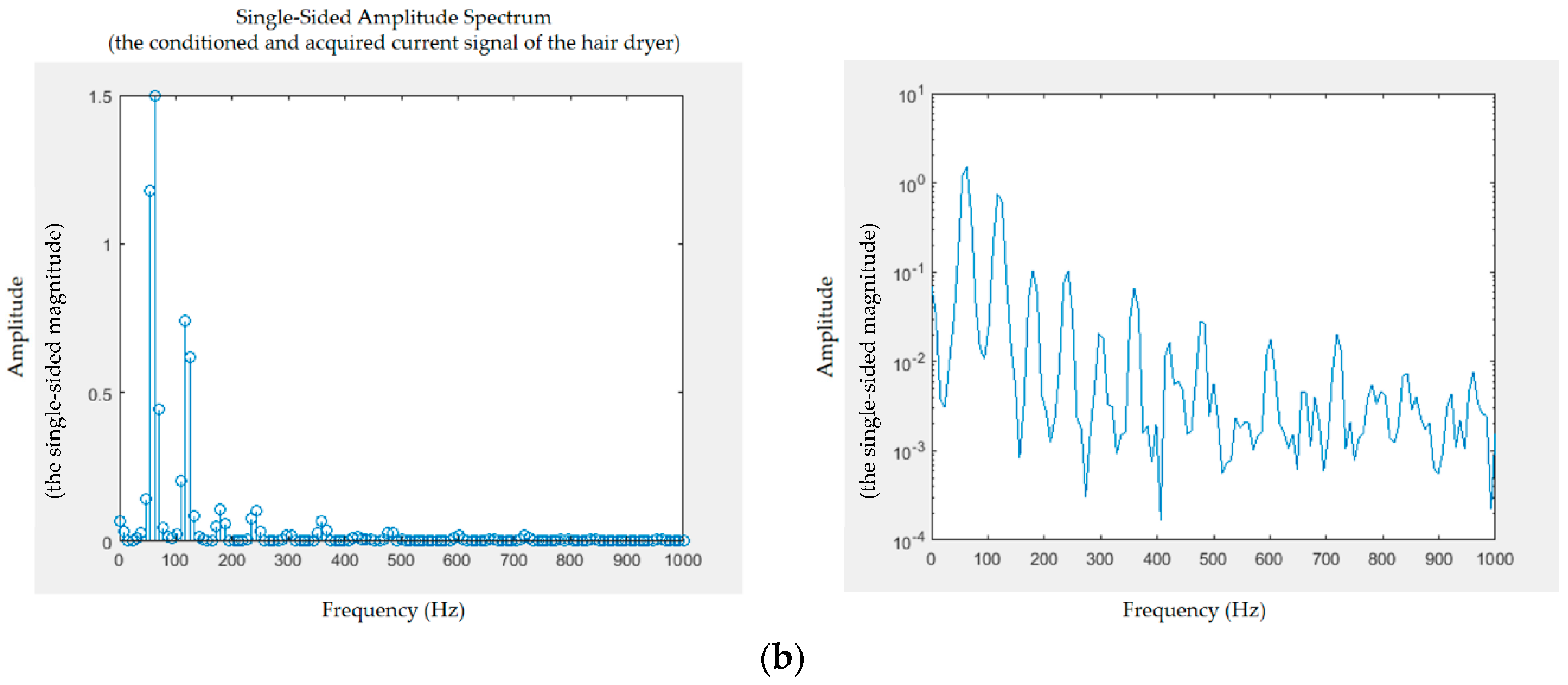
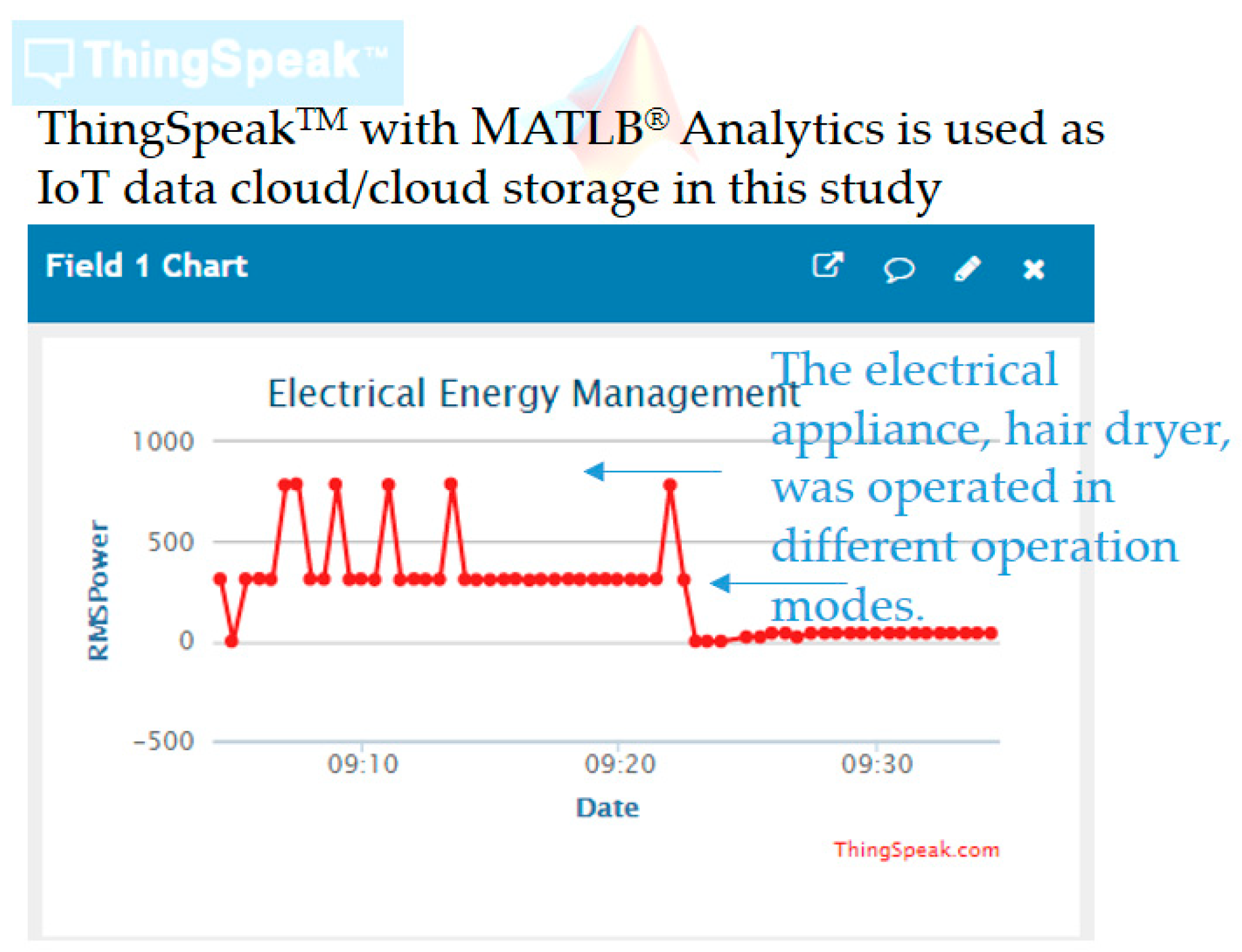
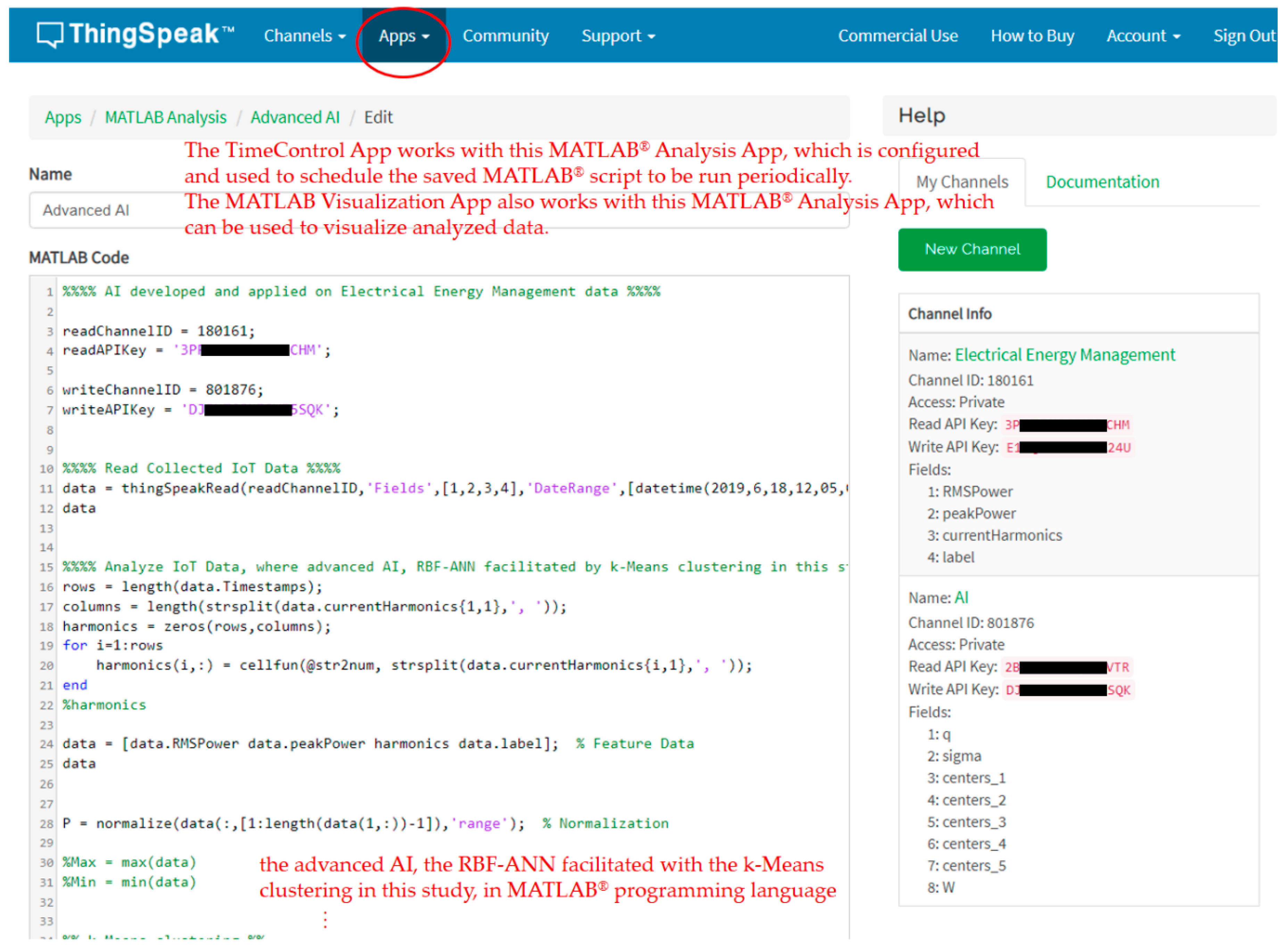
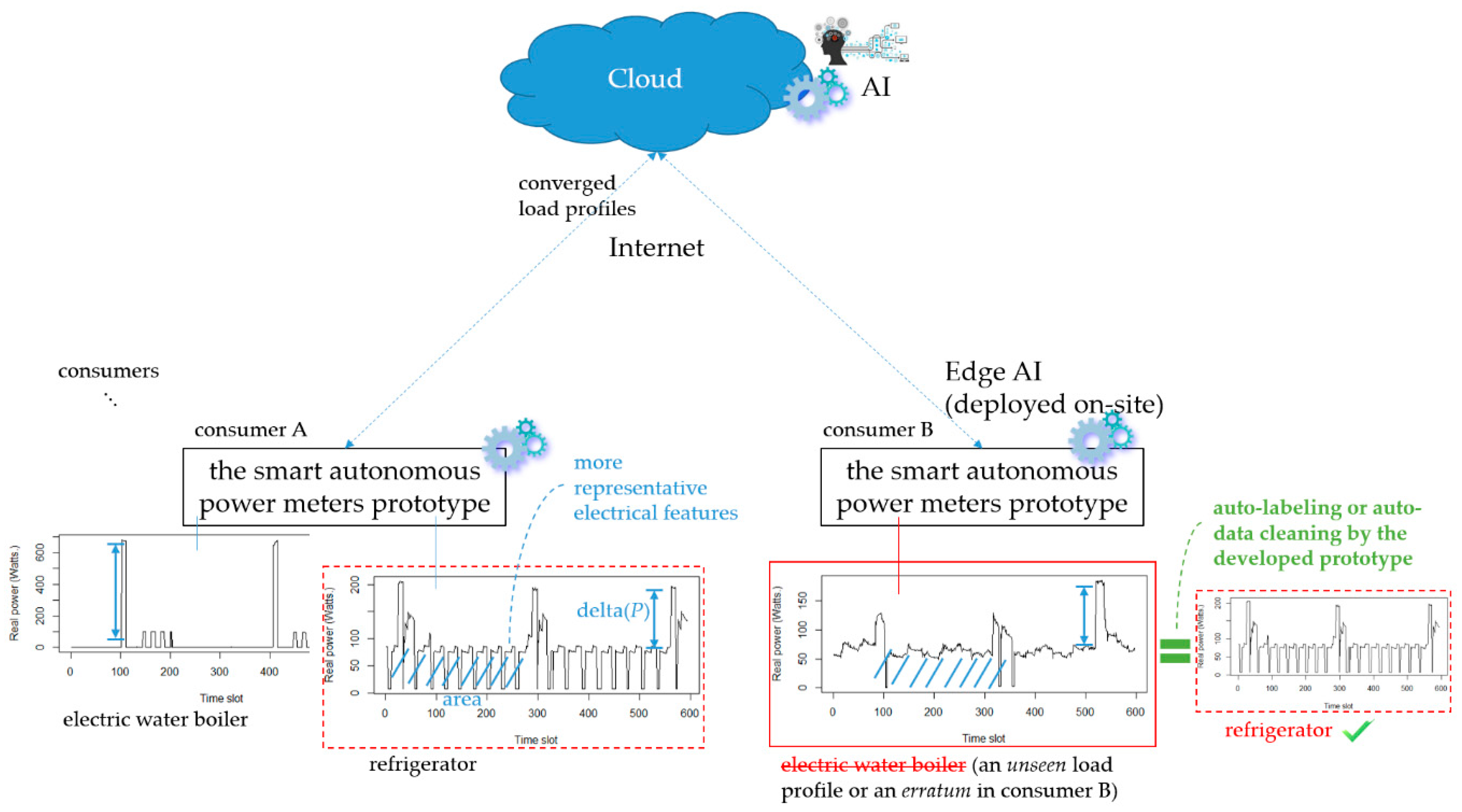
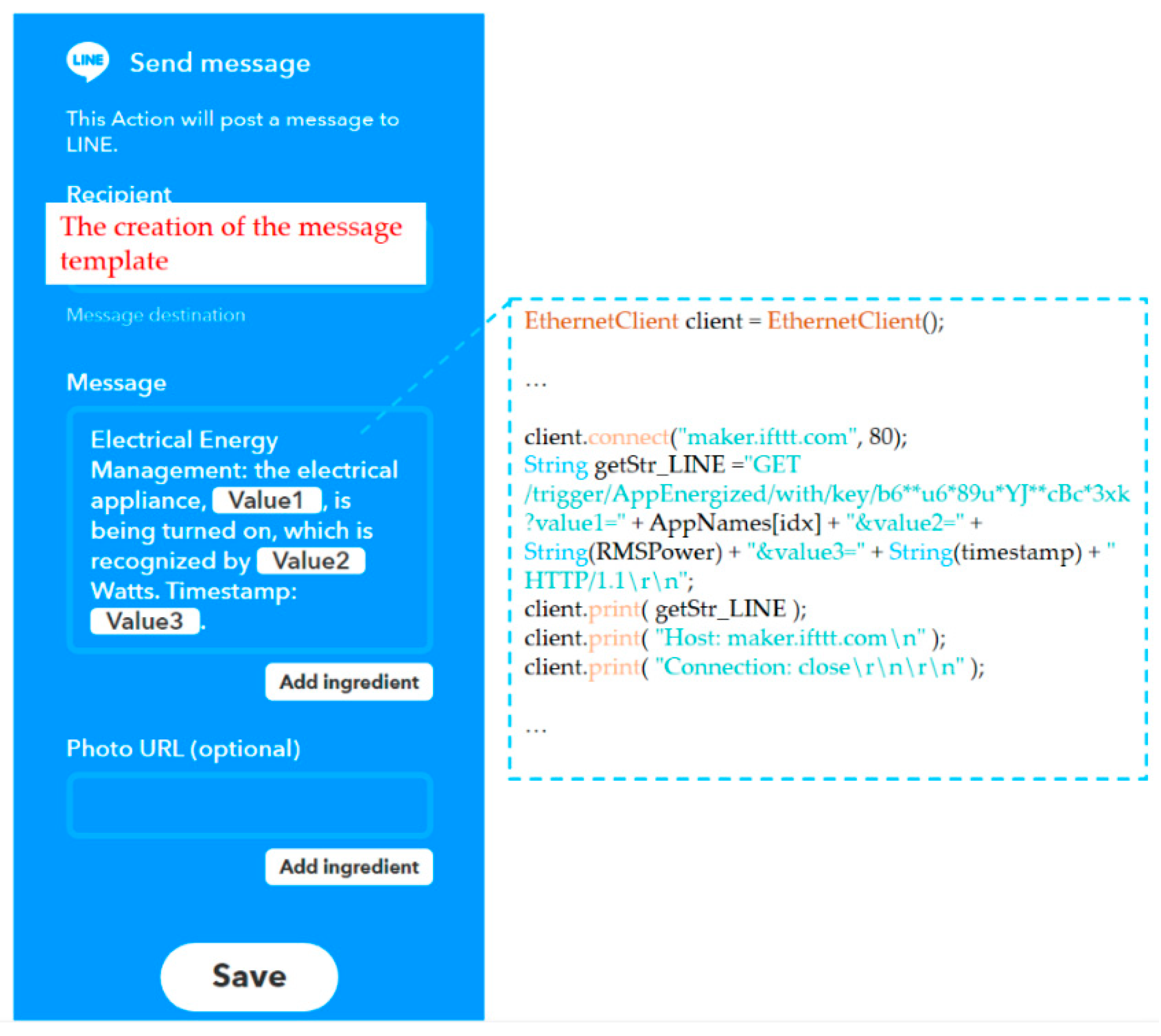
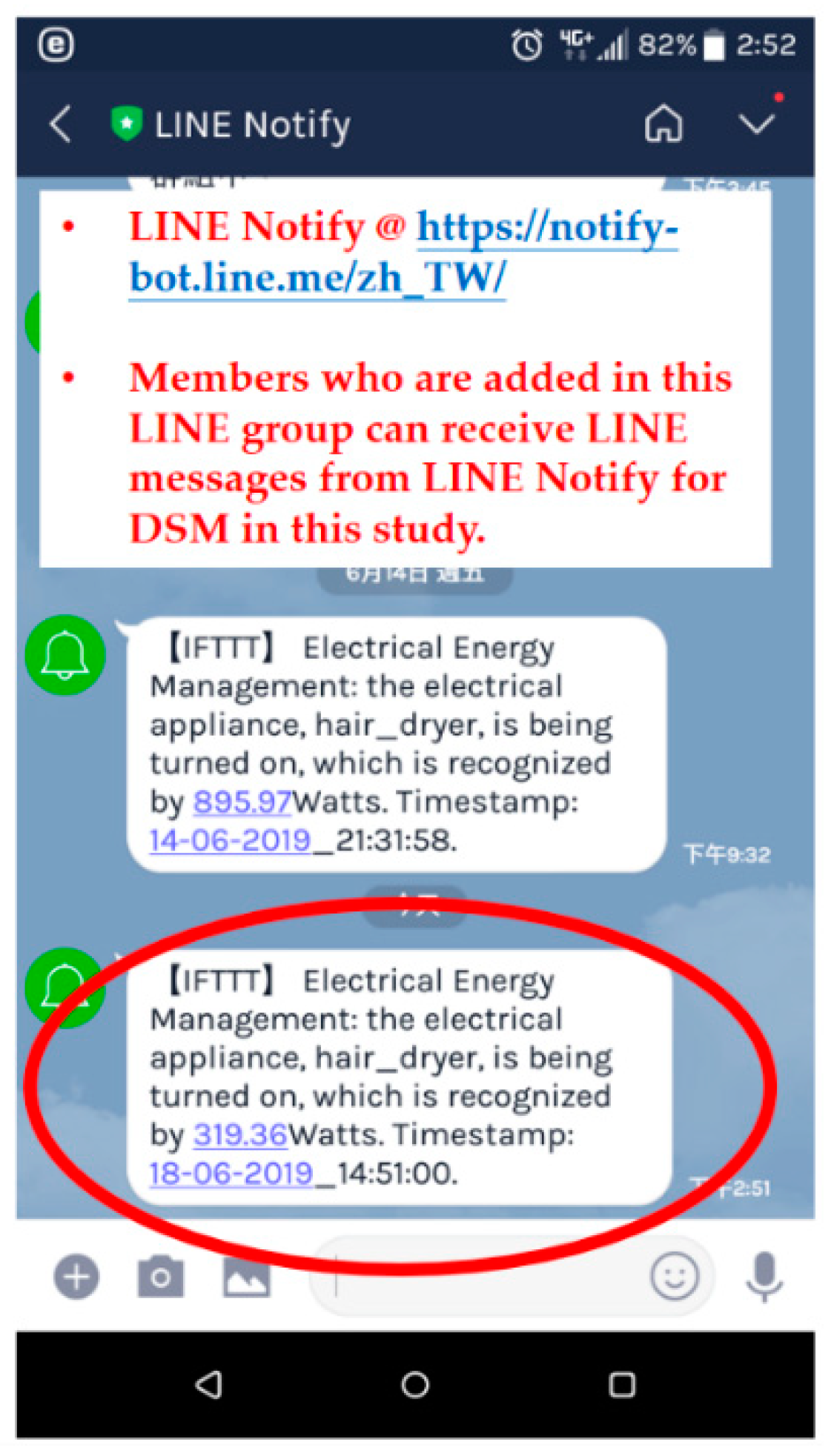
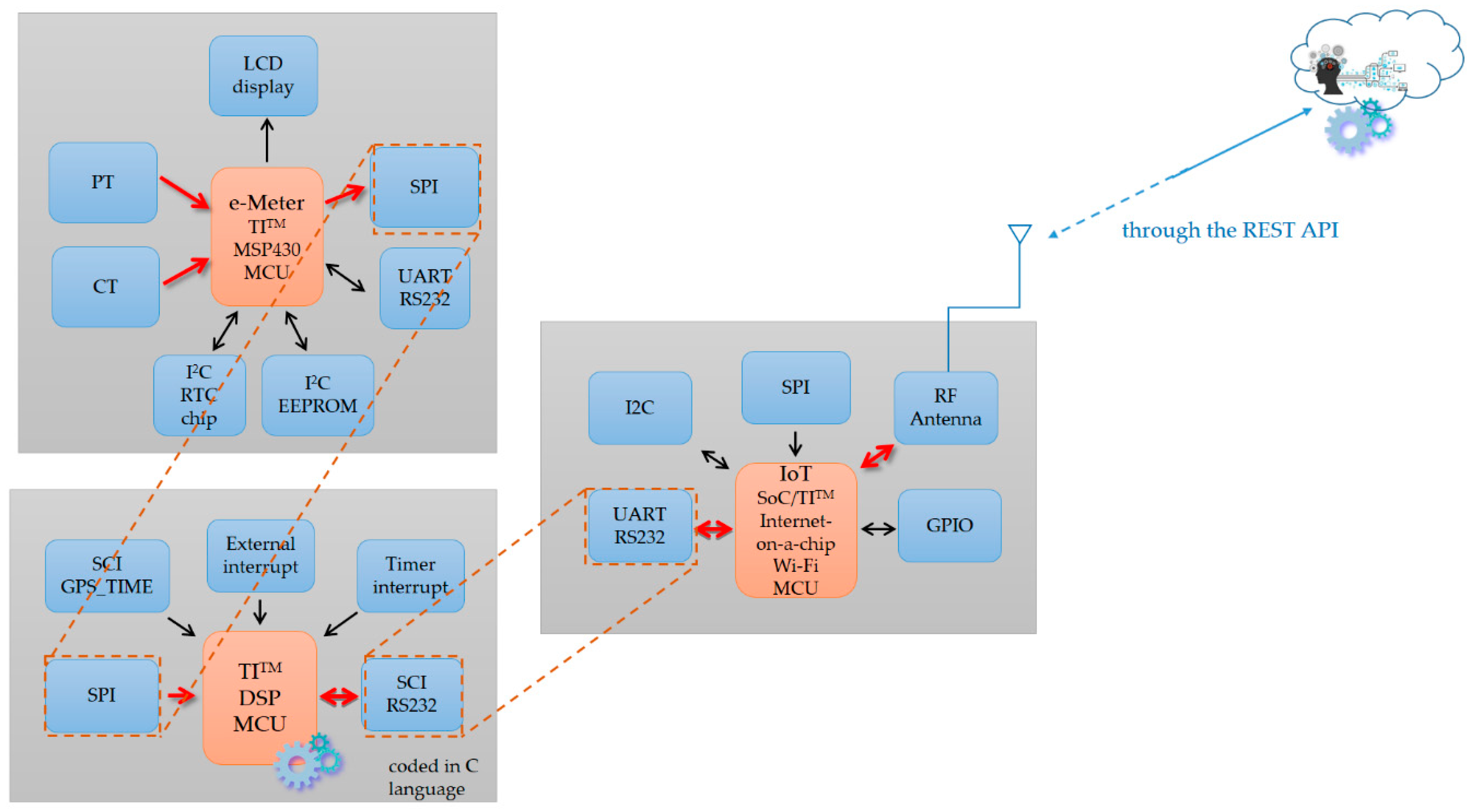
| Arduino® MCU board | ATmega 2560 |
|---|---|
| Operating voltage | 5 V |
| Input voltage (recommended) | 7–12 V |
| Digital input/output (I/O) pins | 54 (of which 15 provide PWM output) |
| Analog input pins | 16 |
| Direct current (DC) per I/O pin | 20 mA |
| DC for 3.3 V pin | 50 mA |
| Flash memory | 256 KB (8 KB used by the bootloader) |
| SRAM | 8 KB |
| EEPROM | 4 KB |
| Clock speed | 16 MHz |
| LED_BUILTIN, number of pins on-board LED is connected to | 13 |
| Size (length × width) | 101.52 mm × 53.3 mm |
| Electric Fan | DC Offset | Fundamental Harmonic (60 Hz) | 2nd-Order Harmonic | 3rd-Order Harmonic | 4th-Order Harmonic | 5th-Order Harmonic |
| 0.002 | 0.144 | 0.000 | 0.018 | 0.000 | 0.003 | |
| 6th-order harmonic | 7th-order harmonic | 8th-order harmonic | 9th-order harmonic | |||
| 0.000 | 0.001 | 0.001 | 0.001 | |||
| Hair Dryer | DC Offset | Fundamental Harmonic (60 Hz) | 2nd-Order Harmonic | 3rd-Order Harmonic | 4th-Order Harmonic | 5th-Order Harmonic |
| 0.070 | 1.498 | 0.741 | 0.105 | 0.103 | 0.020 | |
| 6th-Order Harmonic | 7th-Order Harmonic | 8th-Order Harmonic | 9th-Order Harmonic | |||
| 0.066 | 0.016 | 0.028 | 0.002 |
| Channel | Field | Physical Meaning/Sensor |
|---|---|---|
| Electrical energy management | Field 1 (RMSPower 1) | Real power/CT |
| Field 2 (Ptransient/peakPower) | Turn-on transient power/CT | |
| Field 3 (maximum magnitude up to 9th-order current harmonics) | Current harmonics/CT | |
| Field 4 (label) | Advanced AI | |
| AI (RBF-ANN facilitated by k-means clustering) | Field 1 (q (= c by k-means clustering)) | – |
| Field 2 (σ) | – | |
| Field 3 (centers by k-means clustering) | – | |
| Field 4 (centers by k-means clustering) | – | |
| Field 5 (centers by k-means clustering) | – | |
| Field 6 (centers by k-means clustering) | – | |
| Field 7 (centers by k-means clustering) | – | |
| Field 8 (W) | – |
| /* … */ … String currentHarmonics = ““; byte server[] = { 184, 106, 153, 149 }; // IP address (or api.thingspeak.com) for ThingSpeak (https://thingspeak.com/) String writeAPIKey = “Ex8QxxxTxxxxxx4U”; // Write API key for a ThingSpeak channel … … updateThingSpeak(“field1=“ + String(RMSPower) + “&field2=“ + String(peakPower) + “&field3=“ + currentHarmonics); … … void updateThingSpeak(String tsData) { // RMSPower, peakPower (Ptransient), current harmonics, …more if (client.connect(server, 80)) { Serial.println(F(“Connected to ThingSpeak...”)); client.print(“POST /update HTTP/1.1\n”); client.print(“Host: api.thingspeak.com\n”); client.print(“Connection: close\n”); client.print(“X-THINGSPEAKAPIKEY: “+writeAPIKey+”\n”); client.print(“Content-Type: application/x-www-form-urlencoded\n”); client.print(“Content-Length: “); client.print(tsData.length()); client.print(“\n\n”); client.print(tsData); } … } … |
| Cluster center 1 | P | Turn-on transient power | DC offset | Fundamental harmonic (60 Hz) | 2nd-order harmonic | 3rd-order harmonic |
| 0.394 | 0.387 | 0.344 | 0.442 | 0.985 | 0.883 | |
| 4th-order harmonic | 5th-order harmonic | 6th-order harmonic | 7th-order harmonic | 8th-order harmonic | 9th order harmonic | |
| 0.903 | 0.676 | 0.865 | 0.529 | 0.829 | 0 | |
| Cluster center 2 | P | Turn-on transient power | DC offset | Fundamental harmonic (60 Hz) | 2nd-order harmonic | 3rd-order harmonic |
| 0.997 | 0.984 | 0.684 | 0.990 | 0.022 | 0.152 | |
| 4th-order harmonic | 5th-order harmonic | 6th-order harmonic | 7th-order harmonic | 8th-order harmonic | 9th-order harmonic | |
| 0.067 | 0.611 | 0.024 | 1.000 | 0.056 | 0.333 | |
| Cluster center 3 | P | Turn-on transient power | DC offset | Fundamental harmonic (60 Hz) | 2nd-order harmonic | 3rd-order harmonic |
| 0.048 | 0.050 | 0.071 | 0.059 | 0 | 0.168 | |
| 4th-order harmonic | 5th-order harmonic | 6th-order harmonic | 7th-order harmonic | 8th-order harmonic | 9th-order harmonic | |
| 0 | 0 | 0 | 0 | 0 | 0 | |
| Cluster center 4 | P | Turn-on transient power | DC offset | Fundamental harmonic (60 Hz) | 2nd-order harmonic | 3rd-order harmonic |
| 0.391 | 1.000 | 0.474 | 0.437 | 0.970 | 0.818 | |
| 4th-order harmonic | 5th-order harmonic | 6th-order harmonic | 7th-order harmonic | 8th-order harmonic | 9th-order harmonic | |
| 0.900 | 0.667 | 0.857 | 0.500 | 0.667 | 0 | |
| Cluster center 5 | P | Turn-on transient power | DC offset | Fundamental harmonic (60-Hz) | 2nd-order harmonic | 3rd-order harmonic |
| 0 | 0 | 0.042 | 0 | 0 | 0 | |
| 4th-order harmonic | 5th-order harmonic | 6th-order harmonic | 7th-order harmonic | 8th-order harmonic | 9th-order harmonic | |
| 0 | 0 | 0 | 0 | 0 | 0 |
| W | 0.478 |
| 0.901 | |
| 4.966 | |
| 0.320 | |
| −4.445 |
| K-means clustering (k = 5) combined with RBF-ANN (λ = 0.05) well trained in the cloud is autonomously and automatically deployed as edge analytics on the developed prototype for onsite and online load identification in DSM | K-means clustering (k = 5) combined with RBF-ANN (λ = 0) | Overall load identification rate improvement (%) | |
|---|---|---|---|
| Overall load identification rate (%) | 94.26 | 88.52 | +5.74 |
© 2019 by the authors. Licensee MDPI, Basel, Switzerland. This article is an open access article distributed under the terms and conditions of the Creative Commons Attribution (CC BY) license (http://creativecommons.org/licenses/by/4.0/).
Share and Cite
Chen, Y.-Y.; Lin, Y.-H. A Smart Autonomous Time- and Frequency-Domain Analysis Current Sensor-Based Power Meter Prototype Developed over Fog-Cloud Analytics for Demand-Side Management. Sensors 2019, 19, 4443. https://doi.org/10.3390/s19204443
Chen Y-Y, Lin Y-H. A Smart Autonomous Time- and Frequency-Domain Analysis Current Sensor-Based Power Meter Prototype Developed over Fog-Cloud Analytics for Demand-Side Management. Sensors. 2019; 19(20):4443. https://doi.org/10.3390/s19204443
Chicago/Turabian StyleChen, Yung-Yao, and Yu-Hsiu Lin. 2019. "A Smart Autonomous Time- and Frequency-Domain Analysis Current Sensor-Based Power Meter Prototype Developed over Fog-Cloud Analytics for Demand-Side Management" Sensors 19, no. 20: 4443. https://doi.org/10.3390/s19204443
APA StyleChen, Y.-Y., & Lin, Y.-H. (2019). A Smart Autonomous Time- and Frequency-Domain Analysis Current Sensor-Based Power Meter Prototype Developed over Fog-Cloud Analytics for Demand-Side Management. Sensors, 19(20), 4443. https://doi.org/10.3390/s19204443






